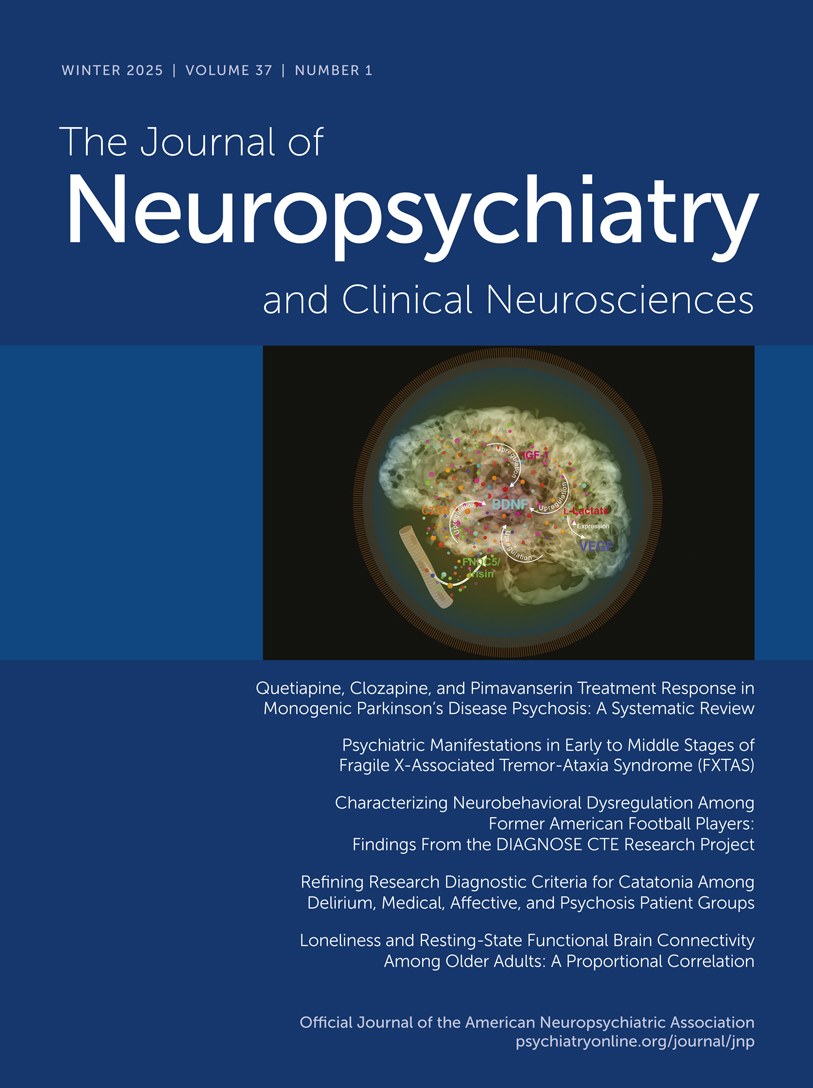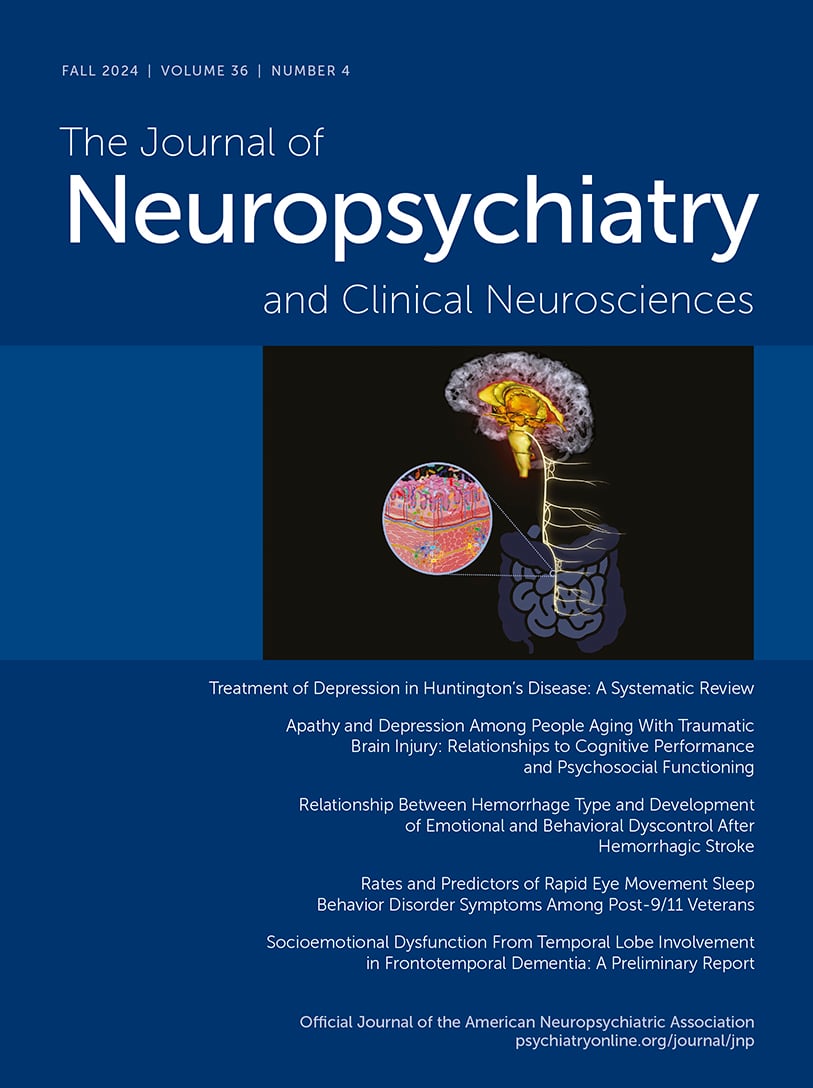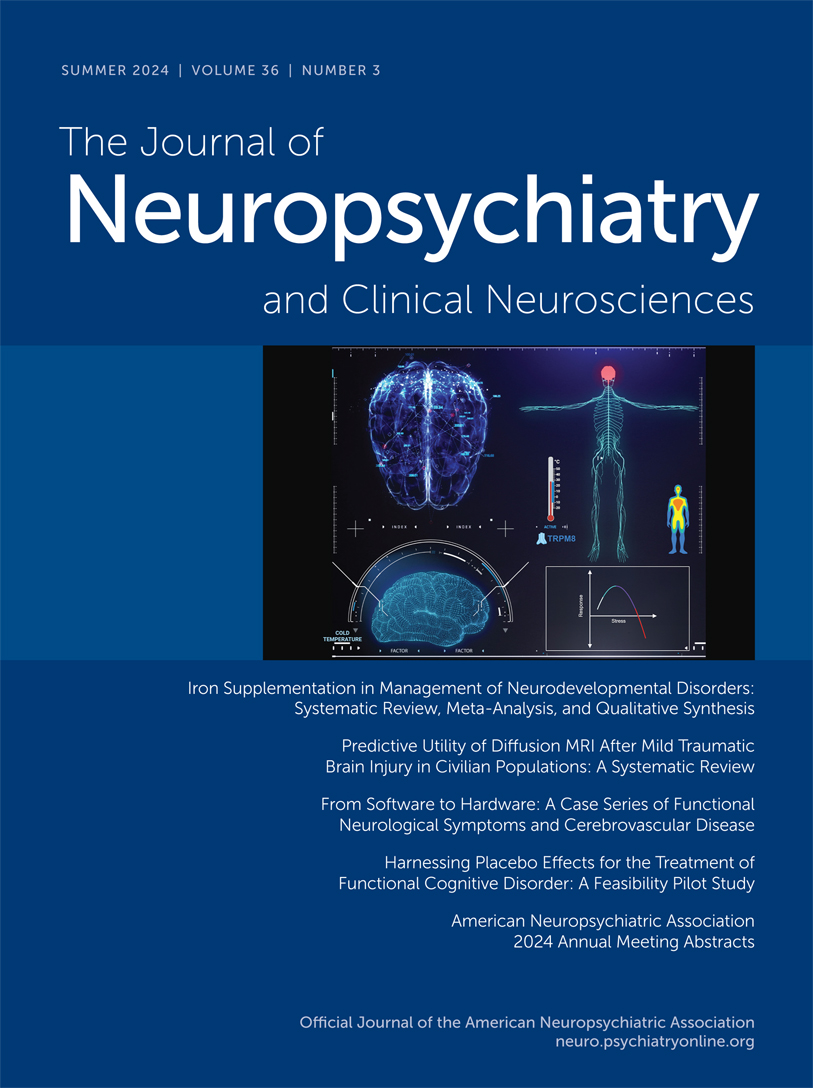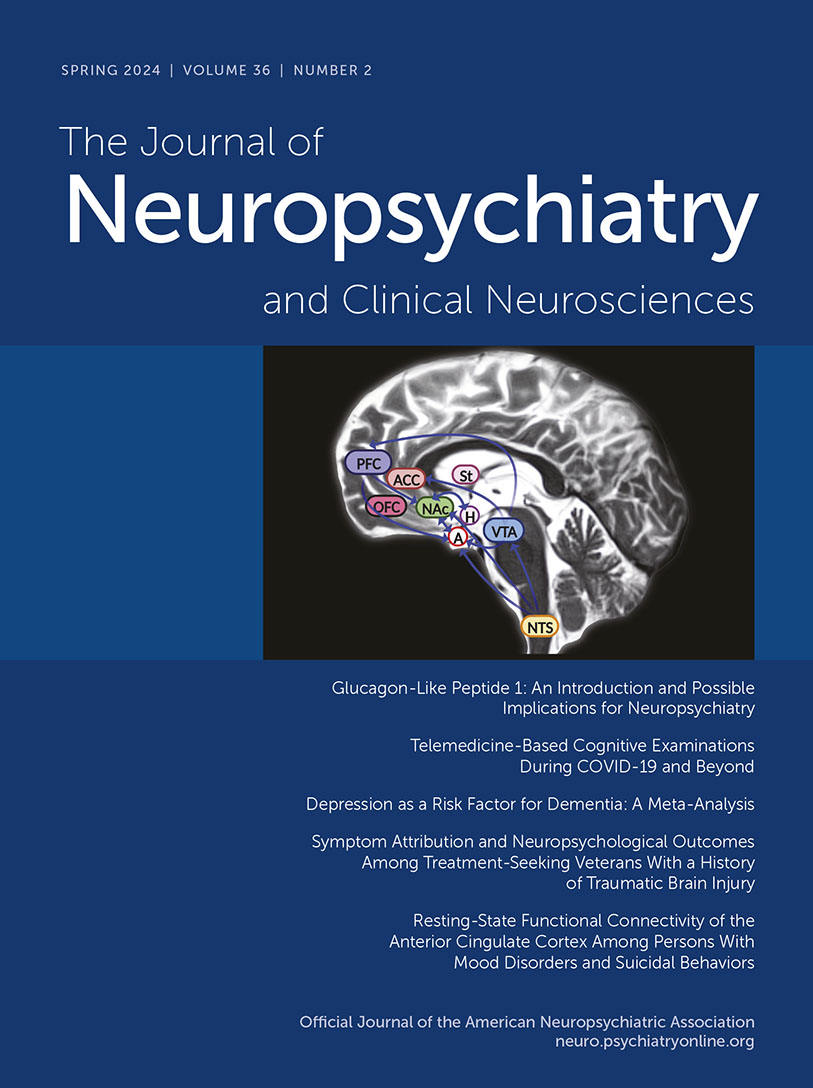The Journal of Neuropsychiatry and Clinical Neurosciences
- Volume 7
- Number 1
- February 1995
Publication date: 01 February 1995
Pages1–5Managed care has decreased the frequency of hospitalization for psychiatric disorders, and it may have an especially strong impact on neuropsychiatric patients. The use of targeted, cost-effective interventions improves the quality of patient care and can ...
https://doi.org/10.1176/jnp.7.1.1Publication date: 01 February 1995
Pages6–14A review of the literature indicates that brain phenylethylamine (PEA) may be a neuromodulator of aminergic synapses and that it promotes energy, elevates mood, and favors aggression. Phenylacetic acid, the main metabolite of PEA, is decreased in the ...
https://doi.org/10.1176/jnp.7.1.6Publication date: 01 February 1995
Pages15–22To test the hypothesis that craving for alcohol in the alcohol- dependent individual is mediated by a limbic circuit involving the caudate nuclei, regional cerebral blood flow was measured with [99mTc]HMPAO SPECT during control and craving conditions in 9 ...
https://doi.org/10.1176/jnp.7.1.15Publication date: 01 February 1995
Pages23–30Apathy occurs frequently in neuropsychiatric disorders both as a symptom of other syndromes and as a syndrome per se. Histories are presented of patients with a syndrome of apathy who showed clinically significant, sustained benefit from pharmacological ...
https://doi.org/10.1176/jnp.7.1.23Publication date: 01 February 1995
Pages31–34Long-term cognitive changes were observed in 8 depressed patients whose pretreatment cognitive impairment (depressive dementia or pseudodementia) resolved after treatment with ECT. Improved performance on the Mattis Dementia Rating Scale was maintained ...
https://doi.org/10.1176/jnp.7.1.31Publication date: 01 February 1995
Pages35–41Eighty normal adults were studied with MRI to investigate the relationship between regional morphology of the corpus callosum and characteristics such as age, gender, education, and cranial size. The variability coefficient was 20% in total callosal area ...
https://doi.org/10.1176/jnp.7.1.35Publication date: 01 February 1995
Pages42–48Day-of-injury computed tomographic scans were compared with postinjury magnetic resonance imaging of 38 patients with traumatic brain injury. Ventricles and several white and gray matter structures were measured. Results demonstrated significant changes ...
https://doi.org/10.1176/jnp.7.1.42Publication date: 01 February 1995
Pages49–53MRI scan reports from 536 psychiatric inpatients in 10 DSM-III-R diagnostic categories and 51 normal control subjects were reviewed for incidence and severity of four types of abnormality: deep white matter hyperintensities, periventricular ...
https://doi.org/10.1176/jnp.7.1.49Publication date: 01 February 1995
Pages54–60Positive neuropsychiatric features (paranoia, delusions, hallucinations) and negative features (disinterest/withdrawal, apathy, reduced speech output, reduced physical activity) occur in Alzheimer's disease (AD), although most studies have focused on ...
https://doi.org/10.1176/jnp.7.1.54Publication date: 01 February 1995
Pages61–67The authors examined relationships between quantified EEG (qEEG) variables and neuropsychological performance in 54 consecutive patients with probable Alzheimer's disease (AD). Patients were studied with qEEG and a neuropsychological battery that assessed ...
https://doi.org/10.1176/jnp.7.1.61Publication date: 01 February 1995
Pages68–71This study investigated the rate of information processing, independent of motor speed, in neurologically affected Wilson's disease (WD) patients. Two scanning tasks based on the Sternberg item-recognition paradigm were administered to 17 neurologically ...
https://doi.org/10.1176/jnp.7.1.68Publication date: 01 February 1995
Pages72–75The cases of 5 patients with seizures occurring the day of or shortly before their weddings are presented. Major life events may precipitate or exacerbate epileptic or nonepileptic seizures as a result of 1) missed medications, 2) sleep deprivation, 3) ...
https://doi.org/10.1176/jnp.7.1.72Publication date: 01 February 1995
Pages76–81This study examined the usefulness of the Alzheimer's Disease Assessment Scale-Late Version (ADAS-L) for assessing cognitive and behavioral impairment in geriatric schizophrenic patients. Subjects were 339 geriatric schizophrenic inpatients. Discriminant ...
https://doi.org/10.1176/jnp.7.1.76Publication date: 01 February 1995
Pages82–89To assess patterns of hearing loss and asymmetry in major depressive disorder (MDD), pure-tone and brief-click audiometric thresholds were measured in 59 inpatients with MDD and 40 normal control subjects. For both tasks, patients had higher bilateral ...
https://doi.org/10.1176/jnp.7.1.82Publication date: 01 February 1995
Pages90–92A 25-year-old woman with multiple sclerosis and an affective disorder probably secondary to MS presented with multiple neurological signs and symptoms suggestive of active MS, most prominently akinetic mutism. Spinal fluid analysis and MRI supported a ...
https://doi.org/10.1176/jnp.7.1.90Publication date: 01 February 1995
Pages92–95When male paranoid schizophrenic subjects attended to a dichotic oddball task requiring target discrimination, their 100-ms latency left hemisphere magnetic auditory sources did not increase in strength, and their source geometry appeared to be degraded, ...
https://doi.org/10.1176/jnp.7.1.92Article
Article
Article
Article
Publication date: 01 February 1995
Page121In D. R. Weinberger et al., "The Frontal Lobes and Schizophrenia," (Fall 1994; 6:419-427), p. 424, column 2, ll. 24-27 should read (change in italics): "For example, in the left prefrontal cortex there is good discrimination of affected from unaffected ...
https://doi.org/10.1176/jnp.7.1.121Past Issues
View Issues Archive
Vol. 37 | No. 1

Vol. 36 | No. 4

Vol. 36 | No. 3
